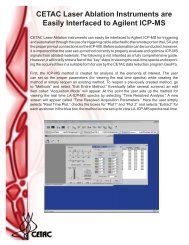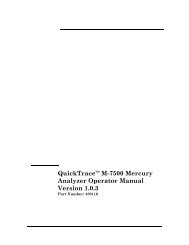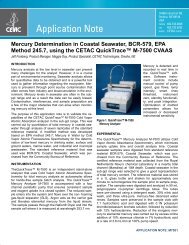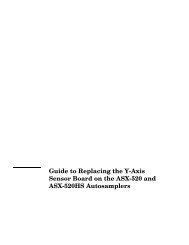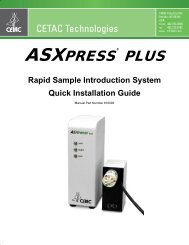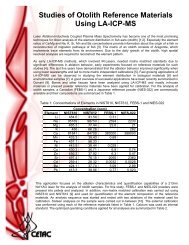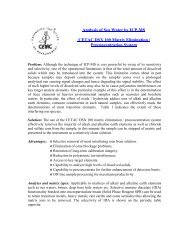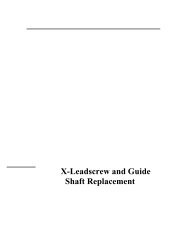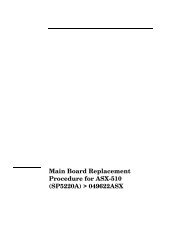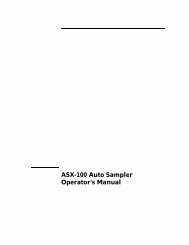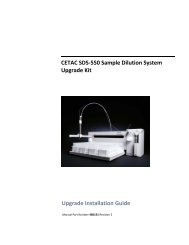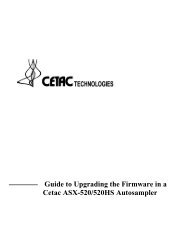CETAC M-7600 Mercury Analyzer Operator's Manual
CETAC M-7600 Mercury Analyzer Operator's Manual
CETAC M-7600 Mercury Analyzer Operator's Manual
You also want an ePaper? Increase the reach of your titles
YUMPU automatically turns print PDFs into web optimized ePapers that Google loves.
Operator’s <strong>Manual</strong><br />
Chapter 6: Troubleshooting the <strong>Mercury</strong> <strong>Analyzer</strong><br />
‣ Check that the peristaltic pump rollers are not severely worn. Inspect all<br />
rollers with tubing removed. Roller facets should not be “grooved.” All<br />
rollers should spin freely when turned by sliding your thumb quickly<br />
across them. None should feel “gritty” or slow in spinning. Replace the<br />
head if any one of the 12 rollers are grooved or fail to move freely.<br />
‣ Ensure the baseline is not drifting severely. (See page 140).<br />
‣ Check that the raw analog system noise is ≤ 400 µAbs peak to peak. If not,<br />
call <strong>CETAC</strong> Support.<br />
Noisy Baseline<br />
‣ Check that flows into and out of the Gas-Liquid Separator are not pulsing.<br />
Pulsation indicates improperly adjusted pump clamps.<br />
‣ Make sure the gas pressures are correct.<br />
‣ Be sure the SnCl 2 is fresh and not oxidized or precipitated.<br />
‣ Ensure the cell windows are clean.<br />
‣ Check that the EOFM filter is clean. Turn the Hg lamp off and ensure that<br />
the EOFM filter is not dirty (inspect it with a dentist’s mirror and low<br />
angle flashlight).<br />
‣ Check that nothing has been spilled on the binocular camera lenses. Turn<br />
the Hg lamp off and ensure that the camera lenses are not dirty (inspect<br />
them with a dentist’s mirror and low angle flashlight). Call <strong>CETAC</strong><br />
Customer Service and Support if the camera lenses are dirty.<br />
Ensure the lamp current is not excessive. For more information see “Adjusting<br />
the Lamp Current” on page 129.<br />
Bad DL<br />
‣ Check Low Absorbance. See “Low Absorbance or No <strong>Mercury</strong> Response”<br />
on page 141 and “Double Peak with Low Absorbance” on page 142.<br />
‣ Check noisy baseline. See page 144.<br />
Sudden Standard Absorbance Rise During Run<br />
‣ Ensure the rinse bottle has acidified rinse.<br />
144



